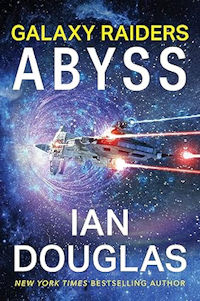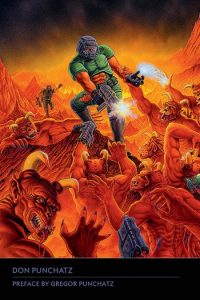Galaxy Raiders: Abyss, by Ian Douglas: Review by Paul Di Filippo
 Galaxy Raiders: Abyss, Ian Douglas (Harper Voyager 978-0063205741, trade paperback, 400pp, $18.99) February 2025
Galaxy Raiders: Abyss, Ian Douglas (Harper Voyager 978-0063205741, trade paperback, 400pp, $18.99) February 2025
I think most folks are well aware of how SF/F/H concepts trickle out into the public domain, and percolate through the minds of citizenry who might never have read a relevant book or even experienced a relevant media presentation. Take “teleportation,” for instance. Once an abstruse notion that meant nothing to the average citizen of 1920, or 1940, or 1970 even, the concept is now intuitively understood and used even for metaphorical purposes in daily conversation. “Man, I’d like to teleport out of the office and straight into my favorite bar!”
The same process happens within the fantastika community, of course, but in a much more powerful, accelerated and purposeful way. Tropes or novums that were once the core engine of a novel, buttressed by deep infodumps and marveled at as groundbreaking, become background furniture in subsequent novels. And in these successor books, the tropes are further refined and elaborated—if the author is conscientious and inventive.
Our novel at hand, Ian Douglas’s Galaxy Raiders: Abyss, is a case in point. It is extremely sophisticated and devoid of infodumps, just grabbing hardware and software off the SF shelf, juggling them like a mad conjuror and further adapting the playthings with fresh and exciting extensions. Douglas expects his readers to be utterly conversant with the latest developments in the field, yet provides just enough background info to accommodate the eager newbie. But this whole performance would have been impossible without writers like Iain Banks, Vernor Vinge, Greg Bear, Gregory Benford, and John Varley pushing the boundaries of ideational civilization forward, deeper into the vast unknown extrapolative storyspace.
We are in the 25th century (that era perhaps a nod to Buck Rogers?), and the galactic situation is incredibly complex. (Douglas does not scant the Earth troubles that intervened between now and his future.) Over a billion years ago, we are told, the Authority was established. Artificial intelligences and other superior beings deemed that every other lower-grade sentient race must obey their rules, towards a goal of peace and stasis. Should a new race arise and attain interstellar travel powers, they are either brought willingly into the fold—or exterminated.
Humanity has now reached this precipice, thanks to having established a few colonies at other star systems.
Our main protagonist in an extensive and colorful cast is Alexandra Morrigan. Born during the early 21st century, she is now 400 years old, thanks to the perfection of human rejuve techniques. But after so much living, she is getting tired of life and seriously contemplating the abandonment of her next rejuve. (Do I detect a bit of Lazarus Long here?) Is there anything that could reawaken her spirit and interest in life? Well, the possibility of planetary extinction finally does the trick.
Having served in Earth’s armed forces in the past (the planet is divided into five spheres of national power and interest), specifically the forces of the USA, Morrigan reenlists and soon attains admiral status, placed in charge of a huge fleet of warships under her vessel the Constellation.
Humans now know that the galaxy is threaded with Authority stargates, linked in a complex pattern. Three such exist at the edge of our Solar System. Having been informed by a Galactic representative of their limited options, Earth has decided to send a powerful mission through the stargate dubbed Abyss, to meet and reason with the Galactics, backed by a show of force.
By the way, here’s a certain type of Galactic:
One’s body was obviously a machine of extremely advanced design, a meter-tall mass floating just at eye-level on silent gravs. It was roughly ovid but with a gleaming silver surface constantly shifting and changing, as though it were made of liquid mercury, an alien analogue to the coronas present in the room. Morrigan suspected that it represented some type of advanced nanotechnology—trillions of cell-sized machines held together by a magnetic or gravitic magic far beyond current human technology.
The thing had eyes…a dozen deep red cabochons of different sizes, like rubies, floating in the silvery liquid surface.
The “coronas” referenced above are high-tech headbands worn by humans, allowing them to communicate mentally with their own AIs and other humans, and to receive instant integrated info-dumps and search out any piece of knowledge. Douglas does a fine job portraying the reality of such a wired condition, especially during battle scenes.
Off the fleet goes. Barely on the far side of the gate, they get their tails whupped and retreat. So much for the option of assimilation. War is now on.
The remainder of the book follows Morrigan and her beefed-up fleet back through the Abyss gate and onward along the galactic star-trails. (These ships self-repair and reform thanks to nanotech.) Onboard is a rogue Galactic named Pax, who might or might not be a true ally. Earth is finally attacked. There are dozens of battles in the vacuum, big and small, brilliantly and vividly staged. Superscience blowouts that Doc Smith would have loved are richly strewn throughout the action.
HELfire beams from the fleet had been slicing through the Galactic fleet for several seconds already. Many ships appeared to be well armored against high-energy beam attacks, but others had been gutted, spilling gases and stored liquids into space where they froze into vast, glittering clouds illuminated by the internal pyrotechnics of dying Galactic ships. Microsingularities from the enemy vessels’ power plants were breaking free from their power generators, plunging through ship structures, absorbing mass in uncontrolled gulps, and vomiting insanely radiant flares of radiation in wavelengths ranging from the visible spectrum through to low gamma wavelengths. Most of the visible light was blue and violet, Illiminating the expanding clouds of ice mist in shimmering sheets of cerulean and ultramarine.
There are interpersonal dilemmas. (The career of fighter pilot John Damian, a kind of Han Solo figure, is a nice arc, and the book’s ending finds him at an unexpected major turning point.) There is gradual discovery of the true savage—and cowardly—nature of the Galactics. There are alien races, including new allies. There is treachery from other humans. This rollercoaster ride just doesn’t stop until the final pages, where Morrigan and company, at a temporary lull, contemplate their next steps.
Douglas has crafted a state-of-the-art space opera that honors the traditions of the past and carries them forward into new realms. Anyone who enjoys the work of Neal Asher will settle down happily here. A barebones entry on Amazon hints at the next installment in October of 2025.
Interested in this title? Your purchase through the links below brings us a small amount of affiliate income and helps us keep doing all the reviews you love to read!
 While you are here, please take a moment to support Locus with a one-time or recurring donation. We rely on reader donations to keep the magazine and site going, and would like to keep the site paywall free, but WE NEED YOUR FINANCIAL SUPPORT to continue quality coverage of the science fiction and fantasy field.
While you are here, please take a moment to support Locus with a one-time or recurring donation. We rely on reader donations to keep the magazine and site going, and would like to keep the site paywall free, but WE NEED YOUR FINANCIAL SUPPORT to continue quality coverage of the science fiction and fantasy field.
©Locus Magazine. Copyrighted material may not be republished without permission of LSFF.









